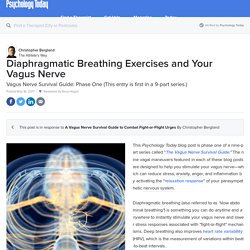

A Vagus Nerve Survival Guide to Combat Fight-or-Flight Urges. Medically accurate illustration of the vagus nerve.

Source: Sebastian Kaulitzki/Shutterstock All too often, the readily accessible power of the vagus nerve to lower anxiety and reduce inflammation is overlooked and underestimated. Over the years, I’ve written a wide range of Psychology Today blog posts that highlight practical ways to tap into the ability of your vagus nerve to combat the cortisol producing stress response of fight-or-flight. article continues after advertisement In 1921, a German Nobel Prize-winning physiologist, Otto Loewi, discovered that stimulating the vagus nerve caused a reduction in heart rate by triggering the release of a substance he coined Vagusstoff (German for “vagus substance”).
The vagus nerve is the prime driving force of the parasympathetic nervous system which regulates our “rest-and-digest” or “tend-and-befriend” responses. Vagus nerve stimulation (VNS) using an implanted device is one clinically proven way to achieve this outcome. Breathing. Physical Fitness. Expressive Narrative Journaling. Awe. Loving-Kindness Meditation. Flow. Diaphragmatic Breathing Exercises and Your Vagus Nerve. Medically accurate illustration of the vagus nerve.

Source: Sebastian Kaulitzki/Shutterstock This Psychology Today blog post is phase one of a nine-part series called "The Vagus Nerve Survival Guide. " The nine vagal maneuvers featured in each of these blog posts are designed to help you stimulate your vagus nerve—which can reduce stress, anxiety, anger, and inflammation by activating the "relaxation response" of your parasympathetic nervous system. article continues after advertisement Diaphragmatic breathing (also referred to as "slow abdominal breathing") is something you can do anytime and anywhere to instantly stimulate your vagus nerve and lower stress responses associated with "fight-or-flight" mechanisms.
For millennia, yogis and sages from Eastern cultures have understood the importance of diaphragmatic breathing. In 2014, Paul M. "What Type of Diaphragmatic Exercises and Technique Should I Use? " Tonic Levels of Physical Activity Stimulate Your Vagus Nerve. Medically accurate illustration of the vagus nerve.

Source: Sebastian Kaulitzki/Shutterstock This Psychology Today blog post is phase two of a nine-part series called "The Vagus Nerve Survival Guide. " The nine vagal maneuvers featured in each of these blog posts are designed to help you stimulate your vagus nerve—which can reduce stress, anxiety, anger, and inflammation by activating the "relaxation response" of your parasympathetic nervous system. article continues after advertisement Tonic levels of aerobic exercise stimulate your vagus nerve and lower stress responses associated with "fight-or-flight" mechanisms. Why Is it Important to Seek a "Tonic Level" of Daily Physical Activity? When it comes to the dose and intensity of your daily exercise regimen, there is one important caveat: Overtraining or doing too much cardiovascular exercise lowers HRV and reduces vagal tone.
All animals (including humans) seek pleasure and avoid pain. In 1993, Ronald E. Face-to-Face Connectedness, Oxytocin, and Your Vagus Nerve. Narrative Expressive Journaling Could Help Your Vagus Nerve. Gutsy Third Person Self-Talk Utilizes Your Vagus Nerve. Awe Engages Your Vagus Nerve and Can Combat Narcissism. Kindness Towards Oneself and Others Tones Your Vagus Nerve. The Psychophysiology of Flow and Your Vagus Nerve. Paying It Forward: Generativity and Your Vagus Nerve. Reduce Chronic Pain. Sports Performance.